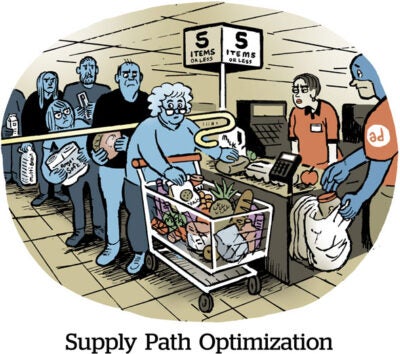The complexity and lack of transparency in the programmatic ad buying ecosystem makes it hard to understand who you’re buying from and how big of a bite they’re taking out of a buyer’s ad spend.
Hence the need for supply-path optimization (SPO).
Simply put, SPO is about buyers identifying the most efficient connections and using them to transact with sellers. The goal is to stop buying through inefficient or expensive paths to supply.
“SPO is really just making deliberate choices about which auctions to participate in and which ones to ignore,” said Jounce Media Founder and President Chris Kane.
Why does the ad industry need SPO?
Supply-path optimization had its first inning in 2017, a few years after the rise of header bidding.
In the old waterfall model of programmatic advertising, publishers ranked supply-side platforms (SSPs) in the ad server according to which SSPs historically produced the highest revenue yield from selling ad inventory. Each SSP would receive bid requests according to the order they were ranked.
Header bidding allowed publishers to consider bids from multiple SSPs simultaneously. All of the publisher’s SSPs can receive bids on each individual ad placement, and the placement goes to the highest bidder. This new setup removed the need for publishers to rank their SSPs according to historical performance and send out bids one by one.
However, in equalizing access to supply, header bidding also introduced more complexity and opacity into the ecosystem. DSPs received dozens of bids for the exact same ad impression.
They suddenly had the opportunity to pick a unique path without losing out on unique inventory. Supply-path optimization was born.
All media buyers needed to do was come up with ways to determine which SSPs would get them the best results.
How do buyers use SPO?
Media buyers use SPO to deliberately focus their bids on the most efficient, most scalable and most transparent supply paths.
A supply path could be an entire SSP. Or it could involve picking specific publishers or specific publisher-SSP pairings that offer the best access and ROI.
Supply-path optimization is “understanding who is touching your inventory and [removing] as many touches as you possibly can,” said Prebid President Mike Racic.
Buyers often hop over their DSP and reach out directly to SSPs to negotiate SPO deals: “What we’re hearing from buyers is that they want to work more deeply with fewer partners,” said Magnite CRO Sean Buckley. “If you’re only working with one or two partners, it becomes much more achievable to build deep, comprehensive relationships.”
 When evaluating an SSP, fees are often the biggest factor. Some SSPs have been willing to cut fees in exchange for a “preferred” relationship with a buyer. Buyers can also look at an SSP’s overall publisher footprint, their strength in certain types of media inventory – like CTV, native or mobile app – or their first-party data-matching capabilities and proprietary audience ID graphs (the utility of which vary widely).
When evaluating an SSP, fees are often the biggest factor. Some SSPs have been willing to cut fees in exchange for a “preferred” relationship with a buyer. Buyers can also look at an SSP’s overall publisher footprint, their strength in certain types of media inventory – like CTV, native or mobile app – or their first-party data-matching capabilities and proprietary audience ID graphs (the utility of which vary widely).
SPO deals are often initiated by brands or at the agency level on behalf of their clients, like GroupM’s Premium Marketplace.
“We cut down dramatically on our number of partners, and by doing that, we’ve been able to get much better benefits and transparency from the core partners we’re still working with,” said GroupM Global Head of Investment Andrew Meaden.
DSPs have also struck preferred relationships with SSPs. Notably, the largest independent DSP, The Trade Desk, created direct relationships with publishers (hopping over the SSP as a gatekeeper). Trade Desk is dubbing this program OpenPath.
“A lot of DSPs are putting out their own solutions around cutting out SSPs, cutting out the ecosystem and just doing direct deals,” Prebid’s Racic said.
Trade Desk’s OpenPath brings to mind how some buyers with their own DSPs, like Criteo and Amazon, have built direct connections into publisher inventory for years now, for the same strategic reasons buyers are pursuing SPO today.
What are the expected results of SPO?
Advertisers doing SPO typically seek to optimize their path to publisher ad inventory by eliminating the “bad actors” from the SSP side of their media buys.
What exactly defines a “bad actor” in this sense? It might be an SSP that demands a larger-than-average take rate or that resells impressions on the open web and pockets the bid difference. SSPs with subpar ad inventory or inadequate protection against data leakage might also go on the chopping block.
When advertisers better understand how their dollars are flowing, fees become transparent and it becomes easier to track down why an ad appeared somewhere (especially in an era where ads show up on fraudulent sites or ones stocked with misinformation).
While one SPO approach might be to cut the worst sites and SSPs with resold inventory and high fees, another SPO approach is to start with identifying the best. Buyers can start with a small pool of approved inventory and SSPs to see if campaigns can perform and scale without access to the murky world of resold or long-tail supply.
Jounce’s Kane advocates a method of SPO that rewards the “good” publishers rather than focusing on cutting out the “bad” SSPs.
“When you think about the internet as one-and-a-half million properties, it’s hard to choose the good ones,” Kane said. “But if you think about it on a seller-by-seller basis, there are, at most, 1,000 sellers that matter – more like 100. So you can just go down the list and pick the ones you trust.”

















